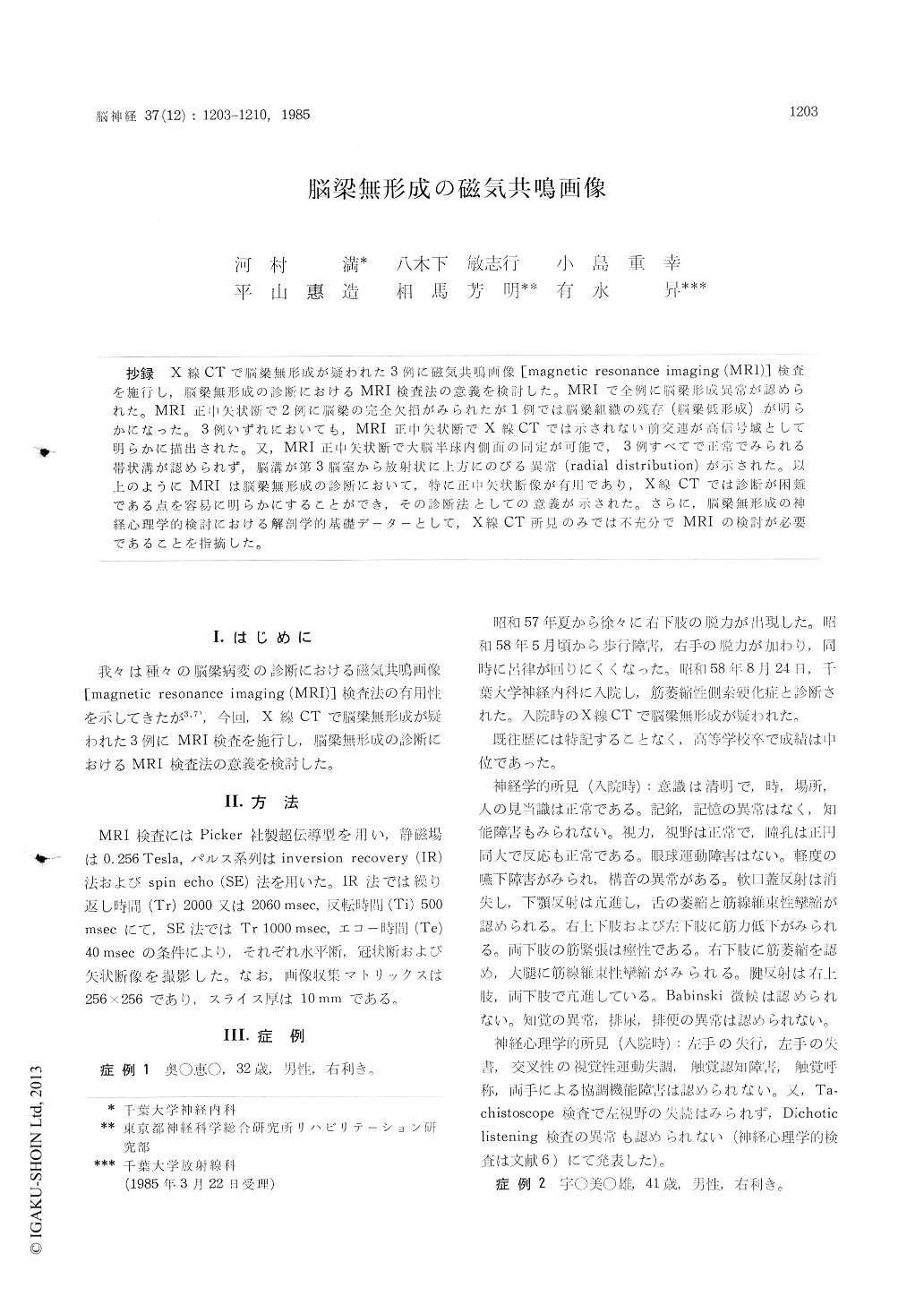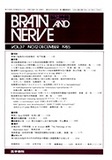Japanese
English
- 有料閲覧
- Abstract 文献概要
- 1ページ目 Look Inside
抄録 X線CTで脳梁無形成が疑われた3例に磁気共鳴画像[magnetic resonance imaging (MRI)]検査を施行し,脳梁無形成の診断におけるMRI検査法の意義を検討した。MRIで全例に脳梁形成,異常が認められた。MRI正中矢状断で2例に脳梁の完全欠損がみられたが1例では脳梁組織の残存(脳梁低形成)が明らかになった。3例いずれにおいても,MRI正中矢状断でX線CTでは示されない前交連が高信号域として明らかに描出された。又,MRI正中矢状断で大脳半球内側面の同定が可能で,3例すべてで正常でみられる帯状溝が認められず,脳溝が第3脳室から放射状に上方にのびる異常(radial distribution)が示された。以上のようにMRIは脳梁無形成の診断において,特に正中矢状断像が有用であり,X線CTでは診断が困難である点を容易に明らかにすることができ,その診断法としての意義が示された。さらに,脳梁無形成の神経心理学的検討における解剖学的基礎データーとして,X線CT所見のみでは不充分でMRIの検討有が必要であることを指摘した。
The recent use of computed tomography (CT) scan is providing an easy diagnoses of agenesis of corpus callosum which had been difficult to diagnose only by clinical signs and symptoms. Since, more neuropsychological studies on agenesis of corpus callosum are being done, clinical details of agenesis of corpus callosum are being clarified.
We examined magnetic resonance imaging (MRI) on 3 patients who were suspected to have agenesis of corpus callosum by CT scan. And we studied the usefulness of MRI in agenesis of corpus callosum.
Case 1. We studied a thirty-two-year-old right-handed man with a one-year history of amyotro-phic lateral sclerosis. He had no callosal discon-nection syndrome. CT scan on horizontal view showed dilated third ventricle, the dilatation of the occipital horns and wide separation of thelateral ventricles. On coronal view, CT scan showed the absence of the corpus callosum, the concave mesial borders of the lateral ventricle, the dilatation of the third ventricle and its ab-normal dorsal extent (bat-wing appearane). On sagittal MRI (the inversion recovery tcchnique), the corpus callosum was absent and the convolu-tions and sulci were arranged radically centering the third ventricle (radial distribution). But the anterior commissure was preserved.
Case 2. We studied a fourty-one-year-old right-handed man with a seven-year history of hyper ventilation syndrome. He had no callosal discon-nection syndrome. CT scan showed the similar findings as these of case 1. On sagittal MRI (the inversion recovery technique), the corpus callosum was absent, and the convolutior,s and sulci showed radial distrtibution. But the anterior commissure was preserved.
Case 3. We studied a fifty-five-year-old right-handed woman with cerebral infarction. She had no callosal disconnection syndrome. CT scanshowed an area of radiolucency in the left fronto-parietal area. And the similar findings as those of case 1 and 2. On sagittal MRI (the spin echo technique), there was hypoplasia of the frontal pole, and low intensity in the mesial part of the fronto-parietal area. The anterior commissure was preserved.
By sagittal MRI, we could easily make a diag-nosis on one case (Case 3) of hypoplasia of corpus callosum which could not been diagnosed by CT scan. On all of the cases, MRI showed the high intensity area of anterior commissure which had not been found by CT scan. Anomaly of cingu-rate gyrus was shown on all of the patients. MRI can show some important points in detail which CT scan can not reveal. The sagittal view espe-cially is the most helpful for diagnosis of agenesis of corpus callosum. And we proposed that neu-ropsychological study on agenesis of corpus cal-losum should have MRI data.

Copyright © 1985, Igaku-Shoin Ltd. All rights reserved.


